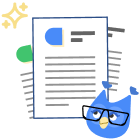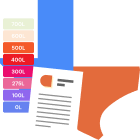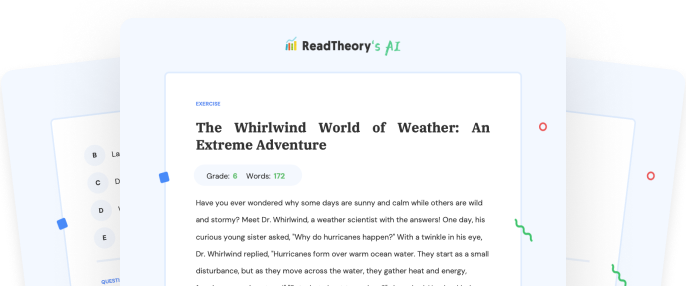Transform Your Teaching
with AI-Powered Worksheets
With ReadTheory’s Instant Worksheet Builder, you can create engaging, grade-appropriate worksheets tailored to your students in minutes. Spark curiosity, save time, and empower critical thinking with AI-powered tools designed for teachers like you.


The Secret Journey of a Story: From Thought to Print
Have you ever wondered how your favorite book came to be? Every book begins as a mere thought, an idea dancing in an author's mind. Slowly, the idea crystallizes into characters and plotlines, forming a manuscript. This manuscript, much like a diamond in the rough, undergoes a process of polishing and refining through editing. With each revision, the story shines brighter. Then comes the publishing stage. The manuscript is transformed into a book, ready to embark on a thrilling journey to bookstores and libraries worldwide. Each book is like a message in a bottle, thrown into the vast sea of literature, waiting for the right reader to discover it. And that reader could be you! When you open a book, you're unlocking a treasure trove of thoughts, dreams, and ideas that the author carefully crafted for you. As you turn each page, you become part of the story's journey, adding your own thoughts and interpretations to it. So the next time you pick up a book, remember, it's more than just a collection of pages. It's a magical journey that started in an author's heart, navigated the world of publishing, and finally found a home in your hands.
Question 1
What does the term 'manuscript' refer to in the context of this passage?
A published book
A thought in an author's mind
An idea for a book
An unfinished version of a book
A bookstore
Question 2
What is the author's purpose of using the analogy of a 'message in a bottle' for a book?
To indicate that books are often lost
To suggest that books can float on water
To convey that books are meant to be discovered by the right reader
To show that books are fragile
To imply that books are small and compact
Question 3
Which stage comes after the editing of the manuscript?
Writing the manuscript
Creating characters and plotlines
Printing the book
Publishing the book
Writing the idea
Question 4
What does the author mean by 'you become part of the story's journey'?
You physically travel with the book
You help write the book
You influence the publishing process
Your thoughts and interpretations contribute to the story
You help sell the book
Question 5
Does the author view the process of creating a book as a magical journey?
Yes
No
The author does not provide an opinion
The author views it as a difficult journey
The author views it as a straightforward process
 or share via
or share via

Assign the ReadTheory pretest to determine students' reading levels.

Why Teachers Love
Instant Worksheet Builder?

Tailored Content for Every Student
Craft worksheets with passages and multiple-choice questions customized to your chosen topic and grade level, ensuring relevance and engagement.

Save Hours
of Prep Time
Our AI, Lexi, generates complete worksheets—passages, questions, and answers—in minutes, freeing you to focus on teaching, not planning.

Standards-Aligned Learning
Every worksheet is designed to boost reading comprehension and critical thinking, aligning seamlessly with State Standards to help your students shine.
Personalized teaching
for personalized learning
Browse worksheets created and refined by educators using Lexi—your source for inspiration and ready-to-use resources.


ReadTheory is free for Teachers to use.
Join thousands of educators using ReadTheory for free. Sign up today and start creating in just minutes!





